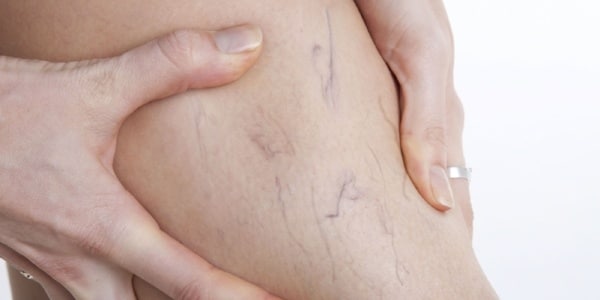
8 Common Myths About Spider Veins
There are a lot of myths and misconceptions when it comes to spider veins. So we asked Jilanne Rose, DPN, ANP-C, a top Metro Phoenix Vein Specialist, to dispel some of the more frequent misconceptions surrounding the cause, risk factors, and treatment of this common vein condition.
Myth #1: Spider Veins are Only Cosmetic
Many people believe that spider veins are unsightly but do not require treatment. Often times, there is underlying venous disease that is a much greater issue.
Myth #2: Spider Veins are Just Part of Getting Older
Although age is one of the risk factors of varicose and spider veins, it’s not the only one and is definitely not the most frequent one. The primary cause of any vein disease is hereditary. In other words, ladies and gentleman, if your mom or grandmother had varicose or spider veins, you are more likely to have them and your age is no longer relevant. In fact, vein disease can start to develop as early as your 20s, and if left untreated, varicose and spider veins will be a natural consequence. Other risk factors include female gender, pregnancy, sedentary lifestyle, being overweight, and having a history of prior leg trauma.
Myth #3: Spider Veins are Strictly a Problem for Women
Incorrect! Spider veins can happen to anyone. It is estimated that as many as 45% of all men will develop some form of venous disease by the time they reach their 60s. The number one cause of varicose veins in both men and women is family history. Lifestyle factors play a significant role as well. If your occupation requires you to stand for long periods, such as medical professionals, factory workers, first responders, sales or restaurant staff, you are more likely to get varicose veins. If you travel and spend long hours flying or driving, or if you sit at a desk for several hours at a time, you are at high risk as well.
Myth #4: Running or Standing Can Cause Spider Veins
Again, this is incorrect. In fact, running, walking or exercise is good for your veins and helps increase circulation. Prolonged standing and sitting in one position does aggravate venous disease and you will notice it more.
Myth #5: Only Overweight People get Spider Veins
Although weight may be a risk factor, a 2015 research article published in Phlebology could not directly link obesity with vein disease, so we can’t really bust that myth. Maintaining a healthy weight and lifestyle can help ease symptoms.
Myth #6: Surgery is the Only Option to Treat Spider Veins
Treatments for venous disease have taken huge leaps forward. Today, there is a range of minimally invasive, maximally effective procedures that can have you back on your feet with a much improved quality of life in very little time. Many of these procedures can be performed in a clinic, on an out-patient basis, with local anesthetic. More often than not, spider veins are treated with non-invasive or minimally invasive techniques that are nearly pain-free.
Myth #7: Vein Treatment is Painful
There was a time when leg vein surgery only referred to procedures such as vein stripping and ligations, painful procedures, likely involving general anesthetic, and definitely involving long and difficult recovery times. There are several modern procedures for varicose veins, spider veins, venous insufficiency and other vascular disease, which, cause minimal pain (if any) and have very fast recovery times. Watch this video from Jilanne Rose to learn more about what you can expect in terms of pain and recovery time .
Myth #8: Vein Treatment is Expensive and Not Covered by Insurance
Many people mistakenly believe that varicose and spider veins are only a cosmetic issue. In reality, the majority of our patients, typically have complaints that indicate an underlying venous condition such as leg pain and/or swelling, restless legs or numbing, tired legs, and leg ulcers. These are real medical problems that significantly impair activities of daily living.
After a full vein exam and ultrasound, patients find that commercial insurance carriers almost always cover vein treatment. Medicare and Medicaid will also cover vein treatment.
Additionally, the latest techniques in Sclerotherapy and Thermal Ablation, are minimally invasive and the costs are considerably lower than what you previously had to pay for a surgery.
It is best to get a complete vein exam and consultation from a qualified vein specialist in order to fully understand your specific circumstances. If you would like to find out if you are at risk of venous insufficiency in the Scottsdale, Phoenix, Mesa or Tempe area, click on the link below to book an appointment.
Question: What can a venous reflux exam tell me? How does this treatment measure my veins effectiveness?
Read MoreQuestion: How long does the actual varicose vein surgery itself take and how much time should I expect for the recovery?
Read MorePregunta: ¿Cuáles son las mejores maneras de juzgar las calificaciones de un médico para el tratamiento de las venas? Mis venas están en forma horrible, y me dijeron recientemente que necesitaría 5 procedimientos diferentes de ablación y 6 citas de escleroterapia después. Tuve mi primer procedimiento VNUS por un médico de la vena en Gilbert…
Read MorePregunta: tuve mis inyecciones (escleroterapia) hace 3 semanas (no en el Instituto de vena avanzada de Arizona). Mi tobillo todavía está terriblemente hinchado. He vuelto dos veces para una ecografía y ningún coágulo. ¿Cuánto dura la hinchazón normalmente? Yo camino y no usar mis medias como se indica. Me está disuadiendo de continuar el tratamiento,…
Read MoreQuestion: What are the best ways to judge a doctor’s qualifications for vein treatment? My veins are in horrible shape, and I was recently told that I would need 5 different ablation procedures and 6 Sclerotherapy appointments afterwards. I had my first VNUS procedure by a vein doctor in Gilbert on the greater saphenous vein, and…
Read MoreQuestion: I had my injections (Sclerotherapy) done 3 weeks ago (not at Advanced Vein Institute of Arizona). My ankle is still terribly swollen. I’ve been back twice for an ultrasound and no clot. How long does the swelling normally last? I walk and did wear my stockings as directed. It is deterring me from continuing treatment…
Read MorePregunta: ¿se pueden tratar las venas normales? Así que tengo venas de color verde azulado muy largas en mi muñeca. Sé que hay normalidad pero odio cómo se ven. ¿Puedo tratarlo con escleroterapia? También tengo 2 largas venas verdes en mi pecho. ¡Ayuda! También tengo 15 años, ¿puedo pasar por la escleroterapia?
Read MoreQuestion: Can normal veins be treated? So I have normal very long green bluish color veins in my wrist. I know there normal but I hate how they look. Can I treat it with sclerotherapy? I also have 2 long green veins in my chest. Help! Also I’m 15, can I go through sclerotherapy?
Read MorePregunta: Tengo 50 años de edad; un soltero, y un maestro. En este momento tengo varices (aunque no son dolorosas) en mi pierna derecha. No estoy feliz de verlos. ¿Qué puede sugerir para disminuir su visibilidad?
Read MoreQuestion: What is “extensive vascular calcium deposits” when shown on X-rays?
Read More